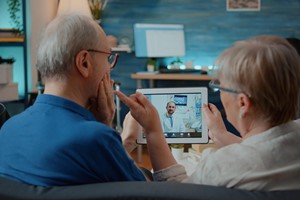At the forefront of surgical innovation, UC Davis Health surgeons are pioneering the use of augmented reality (AR) goggles, a groundbreaking technology that promises to transform surgical procedures and patient education. Augmented reality, which superimposes digital information onto the real world, offers a compelling advantage over virtual reality, which replaces the actual environment with a simulated one. As E. Bradley Strong, professor and vice-chair of otolaryngology at UC Davis, explains, “Extended reality is an umbrella term we like to use to describe them both.”
The UC Davis Medical Extended Reality (MXR) Research Group, formed by surgeons from the Departments of Otolaryngology, Neurological Surgery, and Orthopedic Surgery, is leading the charge in this domain. This group operates within the 3D Printing and Visualization Lab at UC Davis Health and is recognized as the first to utilize extended reality during surgical procedures within the health system. Collaborating with external partners, such as Xironetic, the team aims to be the first globally to integrate AR overlays into a variety of complex surgical operations.
Surgeons don AR goggles during procedures, which project three-dimensional computed tomography (CT) and magnetic resonance imaging (MRI) scans directly onto the surgeon's field of view. This advanced technology enhances surgical capabilities in several critical ways, enabling surgeons to effectively plan their approach, visualize hidden vascular and bone structures, localize instrumentation and implants, and project drilling and cutting guides. According to Strong, “The goggles help us transition our virtual surgical plans to the operating room. It allows us to better view what is in the operative field and visualize objects that otherwise would be very difficult to see in a precise manner.”
The application of extended reality extends beyond the operating room; it also serves as a powerful educational tool for patients. Prior to surgical procedures, surgeons can provide an immersive and interactive experience that aids in patient understanding. Strong notes that “Physicians spend years learning how to piece together many 2D images and then visualize them three-dimensionally. It is impossible to ask patients to do the same thing in 30 minutes. By using this technology, we can give our patients a clear view of what will happen during their surgery.”
A poignant example of this technology’s impact is Richard Odom’s experience prior to his surgical procedure to address an orbital fracture around his right eye. During his consultation at UC Davis Medical Center, Odom was able to explore a floating 3D image of his skull through a headset connected to the extended reality system. By manipulating the visualization with his finger, he could hide the layer of skin over his bone, revealing precisely where an implant would be positioned within his orbit. “It's great to see that the implant won't be just floating around in there,” he remarked. “I feel better knowing exactly where it will be.”
In addition to enhancing patient understanding, extended reality is revolutionizing medical education at UC Davis Health. The integration of physical and virtual environments allows fellows, residents, and medical students to interact with 3D objects instead of viewing static images in textbooks. Strong emphasizes the transformative power of this technology, stating, “It is exciting to see the light bulb go on for them when they are seeing inside the intracranial cavity and looking at an implant that might be malpositioned. We have found this technology to be a very powerful educational tool.”
Looking ahead, the future of extended reality at UC Davis Health appears bright. The technology will be housed within Aggie Square, a cutting-edge research and innovation hub currently under construction on the UC Davis Health Sacramento campus. The 3D Printing and Visualization Lab, MXR research group, and the UC Davis Biomedical Engineering TEAM lab will collaborate to establish the leading visualization and 3D printing lab in Northern California.
Strong anticipates that the use of extended reality in medicine will only increase. “Extended reality is going to get more and more pervasive throughout medicine,” he asserts. “As the technology continues to grow, its use will expand to many different areas of surgery and education, becoming integral to all facets of medical care.”
The integration of augmented reality in surgical practices and patient education represents a significant advancement in healthcare, promising enhanced precision in surgeries and improved understanding for patients. As UC Davis Health continues to lead the way, the potential for augmented reality in medicine is vast, heralding a new era of surgical excellence and patient-centered care.
By Liam Connolly










